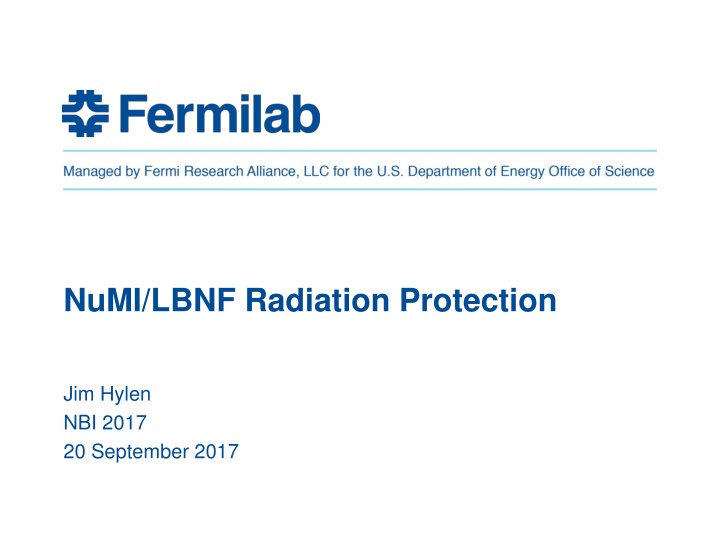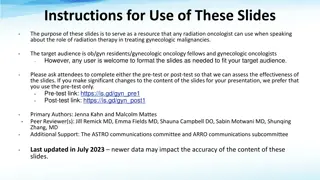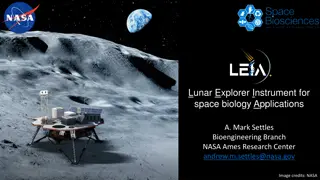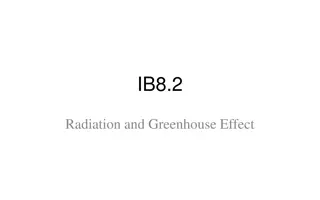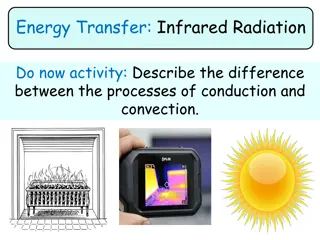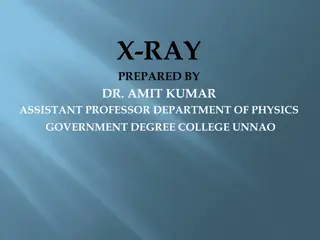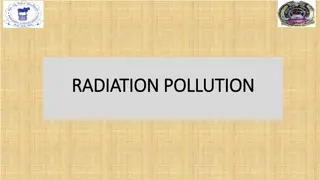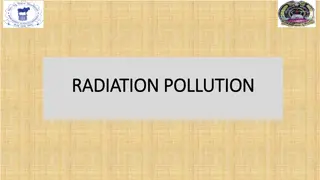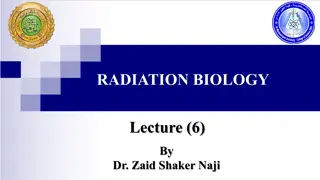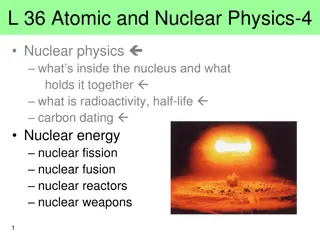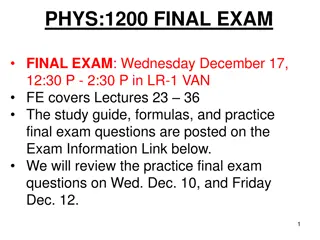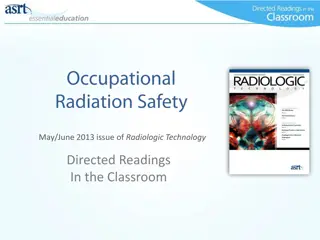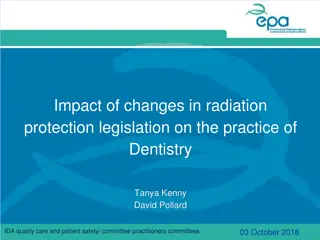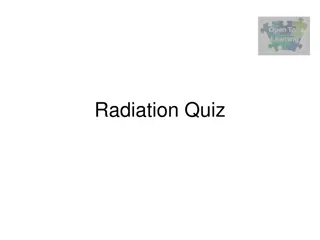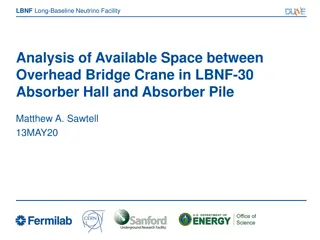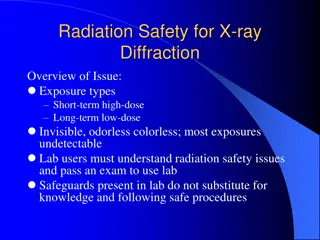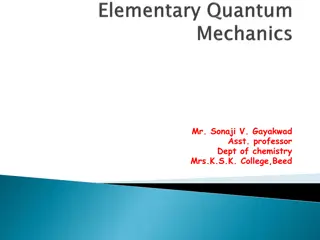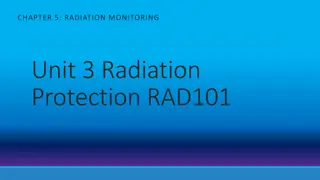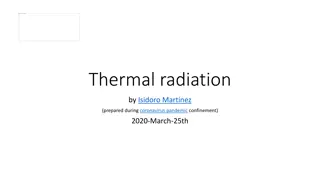NuMI/LBNF Radiation Protection Overview
This overview discusses key aspects of radiation protection at NuMI/LBNF, including air release radiation protection, isotopes of concern, monitoring processes, dose calculation models, and permit limits. The content covers factors like transport, Tritium production, isotopic decay, and public exposure limits set by Fermilab.
Download Presentation

Please find below an Image/Link to download the presentation.
The content on the website is provided AS IS for your information and personal use only. It may not be sold, licensed, or shared on other websites without obtaining consent from the author.If you encounter any issues during the download, it is possible that the publisher has removed the file from their server.
You are allowed to download the files provided on this website for personal or commercial use, subject to the condition that they are used lawfully. All files are the property of their respective owners.
The content on the website is provided AS IS for your information and personal use only. It may not be sold, licensed, or shared on other websites without obtaining consent from the author.
E N D
Presentation Transcript
NuMI/LBNF Radiation Protection Jim Hylen NBI 2017 20 September 2017
Outline Really only going to talk about air release radiation protection Basic features of different air-released radioactive elements Benchmark measurement of 41Ar at NuMI LBNF layout and switch from air to N2in target pile Input from measurement of Tritium releases at NuMI Selection of strategy for LBNF, balancing 11C and 3H concerns An idea for possible ALARA tritium release scheme 2 Jim Hylen | NuMI/LBNF Radiation Protection 9/20/2017
The half-dozen isotopes of concern Short-lived spallation products from interactions in air Production est.: MARS Monte Carlo calculation of hadron flux in air ( > 30 MeV ) times hadronic cross section on air (N, O, Ar) is pretty straight forward Fraction decayed during transport through ventilation can be bracketed reasonably 11C, 13N, 15O Longer-lived spallation product plates out on filters (and other surfaces) Watch for contamination, but properly filtered air not problematic for release 7Be Neutron capture Produced by low energy neutron capture on 40Ar in air More challenging to predict production, because low energy neutrons difficult Longer half-life (110 minutes), so dominant over longer ventilation paths 41Ar 3H Spallation production of Tritium from interactions in shielding Production in shielding, horns, target are reasonably straight forward to calculate Highly mobile, transport through solid and release to air hard to predict Production in air very small compared to evaporation from shielding 3 Jim Hylen | NuMI/LBNF Radiation Protection 9/20/2017
From release point, transport to public Fermilab does continuous monitoring at air release stacks There is a mandated model for calculating the dose to public given the radioisotopes released, location of the release, the weather and the surroundings, all specific to Fermilab. Fermilab permit limits annual exposure to Maximally Exposed Offsite Individual (MEOI) from radioactive air emissions to be less than 100 rem. (Anything above this would result in requirement for continuous EPA approved monitoring) 4 Jim Hylen | NuMI/LBNF Radiation Protection 9/20/2017
Coming up with basis for input to LBNF design NuMI utilizes 2 to 3 hour air decay time (target pile air activation to release point) which keeps short-lived isotope release to a modest fraction of MEOI limit Have been monitoring NuMI air at release points since beginning of NuMI Have been tracking tritium release to air and water Have done cores into concrete shielding to check on tritium migration As input to LBNF design (especially with concern about 41Ar uncertainties) Recently did a test, sampling air inside NuMI target pile for radioisotopes Compared result to MARS prediction Hopefully coming soon to a journal near you: 5 Jim Hylen | NuMI/LBNF Radiation Protection 9/20/2017
Measurement of 41Ar, 11C and 13N in air from NUMI target pile Minimal 2 minute transport of air from NuMI target pile to radiation detectors is corrected for Sampled after many hours of steady state running of beam Normalized to standard way FNAL conservatively estimates for design Conclusions: We are using conservative estimates of production of radio-isotopes MARS and data in reasonable agreement 6 Jim Hylen | NuMI/LBNF Radiation Protection 9/20/2017
LBNF changes: N2 instead of air in target pile and different LBNF air exhaust route BEFORE: air from LBNF target pile sent to NuMI for further decay NEW: N2 from LBNF released from pre-target; NuMI no longer needed Over last several years Saw LARGE increase in Tritium release as NuMI target pile heated up Enlarged LBNF target pile gas vol. and target for optimized beam Motivated change, air -> N2 7 Jim Hylen | NuMI/LBNF Radiation Protection 9/20/2017
LBNF target hall complex Concrete is outside N2 vessel Steel shielding is inside vessel Blue is N2 8 Jim Hylen | NuMI/LBNF Radiation Protection 9/20/2017
Decay pipe and Absorber included in model static Helium fill N2 gas cooling N2 return Absorber outer shielding forced air cooled 9 Jim Hylen | NuMI/LBNF Radiation Protection 9/20/2017
Digression: Gas versus water cooling design philosophy Because LBNF must operate reliably in high radiation areas for decades, a goal for the LBNF design is: all water cooling lines should be replaceable Water-cooled parts are accessible or in modules that can be replaced Gas cooling is used in inaccessible spaces Gas cooling is used for the decay pipe steel and its concrete shielding. Heat load ~ 550 kW Gas cooling is used for the target pile bulk shielding. Heat load ~ 500 kW (2.4 MW beam, optimized horn design) (depends also on details of water cooling panels) Gas selection The large heat loads incline us toward N2 rather than He As comparison, SHIP at CERN design has 2 kW helium heat load I don t know number for T2K or other target piles 10 Jim Hylen | NuMI/LBNF Radiation Protection 9/20/2017
Short-lived isotope strategies ? Three possible strategies: 1. Long ventilation path before release, time for decay of short-lived (like NuMI) 2. Seal vessel and let short-lived isotopes decay before opening box 3. Remove precursors a) removing 40Ar gets rid of 41Ar (longest-lived of the short-lived) b) removing N2, O2 and H2O gets rid of 11C, 13N, 15O Removing O2 and H2O is also desirable to reduce corrosion. For reasons of: Compromise with tritium mitigation vs. short-lived isotope mitigation Reasonable gas cooling of shielding (1 MW deposited heat) Cost and complexity LBNF has picked a mixed strategy of: Small amount of 1. ( ventilation path through target hall and pre-target enclosure) Large effort on 2. (much better seal of target pile vessel) Partial 3. (remove 40Ar, O2 and H2O) Jim Hylen | NuMI/LBNF Radiation Protection 11 Pure N2 in target pile 9/20/2017
Tritium input information NuMI experience says majority of the tritium produced in the steel shielding can come out, especially when shielding gets hot at high beam power ~ 6 Ci / 1020 POT released during low power beam (~300 kW) ~ 23 Ci / 1020 POT released during high power beam (510 kW ave.) 42 Ci / 1020 POT produced (MARS) in target hall + decay region + horns + target Caveats: Absorber is still pretty cool, and don t see much tritium coming out there Some of what is coming out of target pile might be build-up from previous years and eventually be depleted (POT = Protons-On-Target) The large increase in release of Tritium means we have to take greater note of it in LBNF design. MARS results indicate release / POT cannot get hugely worse. T2K has indicated that when opening up their sealed helium vessel, need to ventilate with air for an extended period to reduce tritium to acceptable level for access. (NuMI = continuous air release 9 m3/min while running; no 3H-induced wait for access) 12 Jim Hylen | NuMI/LBNF Radiation Protection 9/20/2017
Tritium Strategies ? Three possible strategies: 1. Trap3H in place; seal (surface coat?) steel shielding or possibly keep steel very cool, to prevent 3H leaking out 2. Extract3H from recirculating gas in vessel, store it and send it to rad-waste dump 3. Continuously release 3H to air, preventing buildup (like NuMI) NuMI shows large temperature dependence of 3H release from the steel shielding For LBNF, pick continuous release while shielding is hot (beam running) - don't build up inventory, so potential source reduced before access - shielding is cool during access, slowing release of what is left - minimizes long-term stored tritium risk & risk of catastrophic release - looks like most cost-effective strategy with least R&D 13 Jim Hylen | NuMI/LBNF Radiation Protection 9/20/2017
Leads to Goldilocks design for target pile vent rate Not too large ( or 11C release is too much ) Not too small ( or will get 3H build-up ) Hopefully LBNF design is just right * Aiming for ~ 50 to 200 liter/minute N2 release each, target pile and decay pipe cooling system 14 Jim Hylen | NuMI/LBNF Radiation Protection 9/20/2017
Sketch of gas flow paths for air release model 15 Jim Hylen | NuMI/LBNF Radiation Protection 9/20/2017
(Part of) Gas flow model for isotope release calculation To pre-target Decay Pipe Cooling N2 Target pile N2 Target Hall Air handling room 16 Jim Hylen | NuMI/LBNF Radiation Protection 9/20/2017
Result of LBNF air release study Input conditions 2.4 MW proton beam power, with LBNF stated design uptime per year Target pile Nitrogen filled (slow purge) Decay pipe cooling also employing Nitrogen (slow purge) Absorber employing Air cooling Release through air-handling room + target hall + pre-target Optimized horn configuration Tritium release scaled from NuMI high power running Using the Fermilab standard (conservative) isotope production methodology Release Point MEOI from short-lived 6% MEOI from Tritium 17% Total MEOI (fraction of limit) 23% LBNF pre-target upstream end Estimated air radiation release well below limit dominated by Tritium 17 Jim Hylen | NuMI/LBNF Radiation Protection 9/20/2017
An idea for further Tritium mitigation Tritium likes to replace one H in water, forming HTO This is how most NuMI tritium is released Releasing to air as HT is much more ALARA (As Low As Reasonably Achievable) Release limit for HT is 10,000 x as much as for HTO In LBNF target pile, where there should be practically no water vapor, could one poison the N2 with small amount of H2, encouraging the formation of HT in the radiation field ? (Released to outside air then in N2 continuous purge). If it works, could be very simple and cheap Needs R&D 18 Jim Hylen | NuMI/LBNF Radiation Protection 9/20/2017
Conclusion Slow controlled purging of LBNF target pile with N2 should: get rid of Tritium continuously in a controlled fashion keep release of 11C, 13N, and 41Ar to acceptable levels Nitrogen in target pile: Is cheap Is a good gas for ~ 1 MW of gas-cooling of shielding (when combined with continuous purge) allows rapid access into target pile when needed for repair, and rapid return to operational state (~ 1 day each way) Mitigates corrosion 19 Jim Hylen | NuMI/LBNF Radiation Protection 9/20/2017
